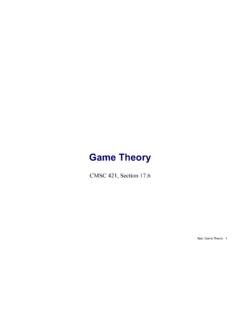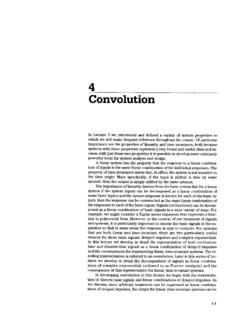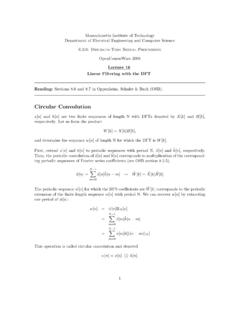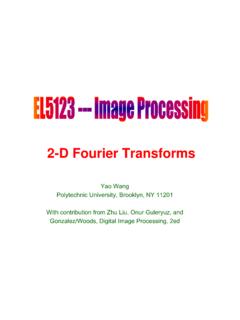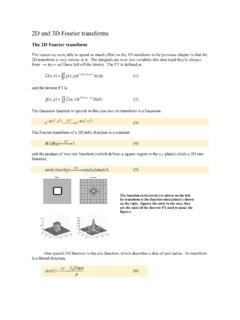Transcription of Correlation and Convolution - UMD
1 Correlation and Convolution Class Notes for CMSC 426, Fall 2005 David Jacobs Introduction Correlation and Convolution are basic operations that we will perform to extract information from images. They are in some sense the simplest operations that we can perform on an image, but they are extremely useful. Moreover, because they are simple, they can be analyzed and understood very well, and they are also easy to implement and can be computed very efficiently. Our main goal is to understand exactly what Correlation and Convolution do, and why they are useful. We will also touch on some of their interesting theoretical properties; though developing a full understanding of them would take more time than we have.
2 These operations have two key features: they are shift-invariant, and they are linear. Shift-invariant means that we perform the same operation at every point in the image. Linear means that this operation is linear, that is, we replace every pixel with a linear combination of its neighbors. These two properties make these operations very simple; it s simpler if we do the same thing everywhere, and linear operations are always the simplest ones. We will first consider the easiest versions of these operations, and then generalize. We ll make things easier in a couple of ways.
3 First, Convolution and Correlation are almost identical operations, but students seem to find Convolution more confusing. So we will begin by only speaking of Correlation , and then later describe Convolution . Second, we will start out by discussing 1D images. We can think of a 1D image as just a single row of pixels. Sometimes things become much more complicated in 2D than 1D, but luckily, Correlation and Convolution do not change much with the dimension of the image, so understanding things in 1D will help a lot. Also, later we will find that in some cases it is enlightening to think of an image as a continuous function, but we will begin by considering an image as discrete , meaning as composed of a collection of pixels.
4 Notation We will use uppercase letters such as I and J to denote an image. An image may be either 2D (as it is in real life) or 1D. We will use lowercase letters, like i and j to denote indices, or positions, in the image. When we index into an image, we will use the same conventions as Matlab. First, that means that the first element of an image is indicated by 1 (not 0, as in Java, say). So if I is a 1D image, I(1) is its first element. Second, for 2D images we give first the row, then the column. So I(3,6) is the pixel in the third row of the image, and the sixth column.
5 An Example One of the simplest operations that we can perform with Correlation is local averaging. As we will see, this is also an extremely useful operation. Let s consider a simple averaging operation, in which we replace every pixel in a 1D image by the average of that pixel and its two neighbors. Suppose we have an image I equal to: Averaging is an operation that takes an image as input, and produces a new image as output. When we average the fourth pixel, for example, we replace the value 3 with the average of 2, 3, and 7. That is, if we call the new image that we produce J we can write: J(4) = (I(3)+I(4)+I(5))/3 = (2+3+7)/3 = 4.
6 Or, for example, we also get: J(3) = (I(2)+I(3)+I(4))/3 = (4+2+3)/3 = 3. Notice that every pixel in the new image depends on the pixels in the old image. A possible error is to use J(3) when calculating J(4). Don t do this; J(4) should only depend on I(3), I(4) and I(5). Averaging like this is shift-invariant, because we perform the same operation at every pixel. Every new pixel is the average of itself and its two neighbors. Averaging is linear because every new pixel is a linear combination of the old pixels. This means that we scale the old pixels (in this case, we multiply all the neighboring pixels by 1/3) and add them up.
7 This example illustrates another property of all Correlation and Convolution that we will consider. The output image at a pixel is based on only a small neighborhood of pixels around it in the input image. In this case the neighborhood contains only three pixels. Sometimes we will use slightly larger neighborhoods, but generally they will not be too big. Boundaries: We still haven t fully described Correlation , because we haven t said what to do at the boundaries of the image. What is J(1)? There is no pixel on its left to include in the average, ie., I(0) is not defined. There are four common ways of dealing with this issue.
8 In the first method of handling boundaries, the original image is padded with zeros (in red italics). The first way is to imagine that I is part of an infinitely long image which is zero everywhere except where we have specified. In that case, we have I(0) = 0, and we can say: J(1) = (I(0) + I(1) + I(2))/3 = (0 + 5 + 4)/3 = 3. Similarly, we have: J(10) = (I(9)+I(10)+I(11))/3 = (3 + 6 + 0)/3 = 3. In the second method of handling boundaries, the original image is padded with the first and last values (in red italics). The second way is to also imagine that I is part of an infinite image, but to extend it using the first and last pixels in the image.
9 In our example, any pixel to the left of the first pixel in I would have the value 5, and any pixel to the right of the last pixel would have the value 6. So we would say: J(1) = (I(0) + I(1) + I(2))/3 = (5 + 5 + 4)/3 = 4 2/3, and J(10) = (I(9)+I(10)+I(11))/3 = (3 + 6 + 6)/3 = 5. 5 4 2 3 7 4 6 5 3 6 .. 0 0 5 4 2 3 7 4 6 5 3 6 0 0 .. 5 5 5 4 2 3 7 4 6 5 3 6 6 6 .. In the third method of handling boundaries, the original image is repeated cyclically (in red italics). Third, we can imagine the image as being like a circle, so that the pixel values repeat over and over again. The pixel to the left of the first pixel, then, would be the last pixel in the image.
10 That is, in our example, we would define I(0) to be I(10). Then we would have J(1) = (I(0) + I(1) + I(2))/3= (I(10) + I(1) + I(2))/3 = (6 + 5 + 4)/3 = 5, and J(10) = (I(9)+I(10)+I(11))/3 = (I(9)+I(10)+I(1))/3 = (3 + 6 + 5)/3 = 4 2/3. Finally, we can simply say that the image is undefined beyond the values that we have been given. In that case, we cannot compute any average that uses these undefined values, so J(1) and J(10) will be undefined, and J will be smaller than I. These four methods have different advantages and disadvantages. If we imagine that the image we are using is just a small window on the world, and we want to use values outside the boundary that are most similar to the values that we would have obtained if we d taken a bigger picture, than the second approach probably makes the most sense.






